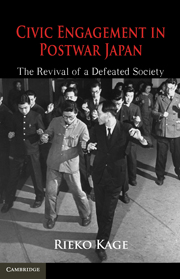Book contents
- Frontmatter
- Contents
- List of Tables
- List of Figures
- Preface
- Acknowledgments
- Civic Engagement in Postwar Japan
- 1 Introduction
- 2 Civic Engagement: The Dependent Variable
- 3 War and Civic Engagement: A Theoretical Framework
- 4 Quantitative Analysis: The Rise of Civic Engagement across Forty-Six Japanese Prefectures
- 5 The Long-Term Effects of Wartime Mobilization: Cross-National Analysis
- 6 Repression and Revival of the YMCA Japan
- 7 Wartime Endorsement and Postwar Repression of a Traditional Art
- 8 Civil Society and Reconstruction in Postwar Japan
- 9 Conclusions
- References
- Index
6 - Repression and Revival of the YMCA Japan
Published online by Cambridge University Press: 06 December 2010
- Frontmatter
- Contents
- List of Tables
- List of Figures
- Preface
- Acknowledgments
- Civic Engagement in Postwar Japan
- 1 Introduction
- 2 Civic Engagement: The Dependent Variable
- 3 War and Civic Engagement: A Theoretical Framework
- 4 Quantitative Analysis: The Rise of Civic Engagement across Forty-Six Japanese Prefectures
- 5 The Long-Term Effects of Wartime Mobilization: Cross-National Analysis
- 6 Repression and Revival of the YMCA Japan
- 7 Wartime Endorsement and Postwar Repression of a Traditional Art
- 8 Civil Society and Reconstruction in Postwar Japan
- 9 Conclusions
- References
- Index
Summary
OVERVIEW
Chapter 4 used quantitative analysis to demonstrate that the combination of path-dependency effects from the prewar period and wartime mobilization crucially shaped the rise of civic engagement in Japan in the initial postwar decade. Participation in youth and religious organizations grew more rapidly in areas where levels of participation had been high prior to the war and that were highly mobilized during wartime. Conversely, areas that had seen low levels of participation during the prewar period and/or were less mobilized during the war saw lower rates of postwar membership growth. Chapter 5 then showed that mobilization had important effects on postwar levels of civic engagement in thirteen countries in Asia, Europe, and North America.
The quantitative analyses, however, did not test the precise mechanisms through which mobilization and historical legacies would affect civic engagement in the postwar period. A separate investigation is required to confirm the causal relationship between prewar, wartime, and postwar levels of participation at the micro-level. The present chapter and the next seek to further test the validity of the hypothesis presented in this project through historical process-tracing.
Chapter 3 argued that in conjunction with mobilization, prewar levels of voluntary participation leave considerable historical legacies, which survive despite the disruption caused by war. The legacies of prewar associational activities, in particular, are hypothesized to operate via two distinct pathways.
- Type
- Chapter
- Information
- Civic Engagement in Postwar JapanThe Revival of a Defeated Society, pp. 95 - 122Publisher: Cambridge University PressPrint publication year: 2010



